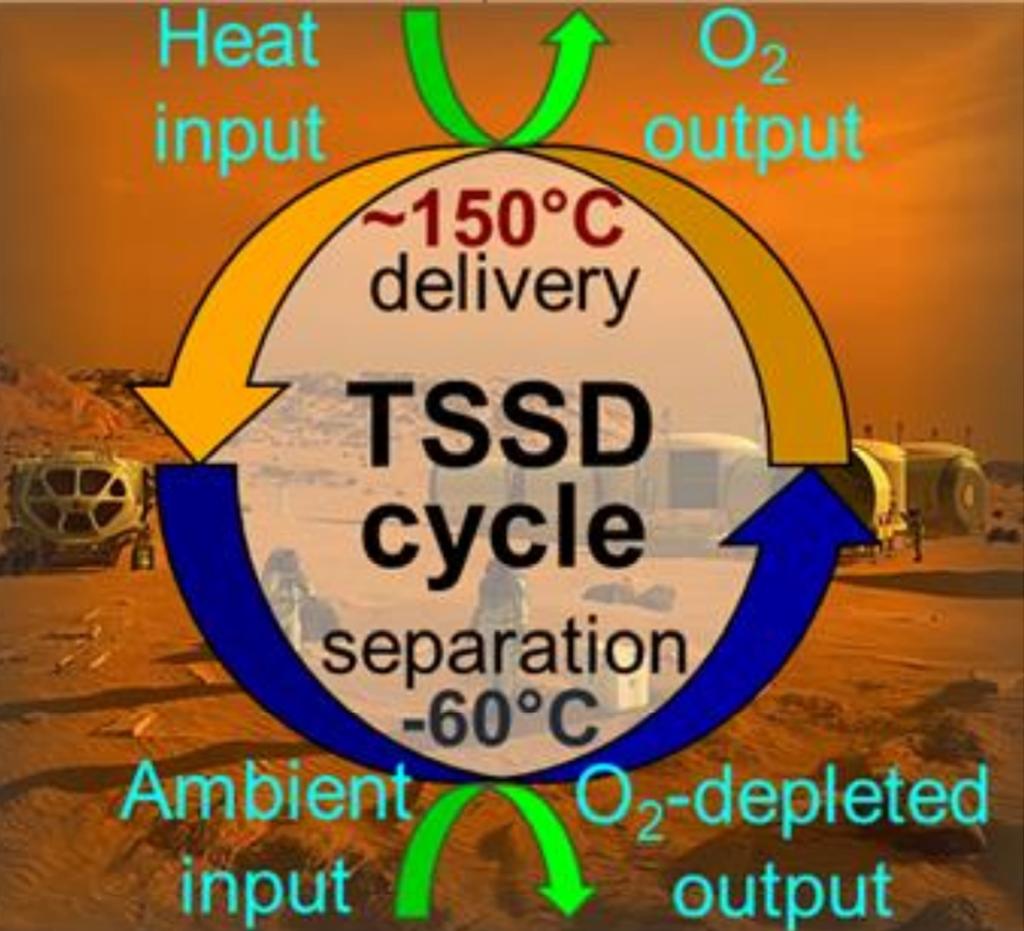
The basis for TSSD is a two-step thermally-driven cycle operating below ~260 C. One of the critical challenges of human Mars missions is the need for in-situ resource utilization (ISRU), especially oxygen–both as Mars Ascent Vehicle (MAV) propellant, and for life support. In addition to the MAV and habitation (same ISRU unit), a baseline “commuter” Mars architecture also envisions small, pressurized rovers for mobility and science. Reliable, portable oxygen generation could extend rover endurance, broaden the exploration zone from the habitation area, and increase the number of science and resource regions of interest accessible permission. Further, larger exploration zones ease the tradeoff between landing site appeal (low risk to astronauts) and proximity to regions of interest (mission success). While desolate to humans, the Martian atmosphere nonetheless contains oxygen.
this approach is motivated by thermodynamics: the minimum theoretical work to separate oxygen from the Mars atmosphere is ~30-50 times lower than to obtain it by splitting carbon dioxide. Efficiency: TSSD is expected to be ~10x more efficient than MOXIE. For MOXIE, the target power requirement for oxygen propellant production is 30 kW. The TSSD estimate is only 4 kW; i.e., 90% less than MOXIE. Applying TSSD in rovers, the estimated power for oxygen production is only ~50 W/person. These advantages expand further if the input is heat, rather than electricity. Flexibility: TSSD has startup times of minutes (versus hours for MOXIE), and is inherently capable of handling intermittencies and restarts. Sealant limits in MOXIE strongly constrain transient tolerance. Simplicity and robustness: TSSD is exceedingly simple, inexpensive, and robust, with no moving parts, and long life. Unlike MOXIE, TSSD is not susceptible to carbon deposition. The maximum process temperature is ~260 C vs. 800 C for MOXIE. If successful as envisioned, TSSD will be a giant leap in Mars ISRU capabilities and can be expected to significantly improve and de-risk human Mars exploration. The potential to expand considerably the exploration zone is especially exciting, as it would allow a far more comprehensive Mars exploration program than currently envisioned. Furthermore, TSSD-based Mars ISRU could pave the way for ISRU in many other environments of interest (e.g. Venus, Europa, or Titan), and ISRU of other gases of interest, such as water (vapor), nitrogen, and carbon monoxide.
Brian Wang is a Futurist Thought Leader and a popular Science blogger with 1 million readers per month. His blog Nextbigfuture.com is ranked #1 Science News Blog. It covers many disruptive technology and trends including Space, Robotics, Artificial Intelligence, Medicine, Anti-aging Biotechnology, and Nanotechnology.
Known for identifying cutting edge technologies, he is currently a Co-Founder of a startup and fundraiser for high potential early-stage companies. He is the Head of Research for Allocations for deep technology investments and an Angel Investor at Space Angels.
A frequent speaker at corporations, he has been a TEDx speaker, a Singularity University speaker and guest at numerous interviews for radio and podcasts. He is open to public speaking and advising engagements.



